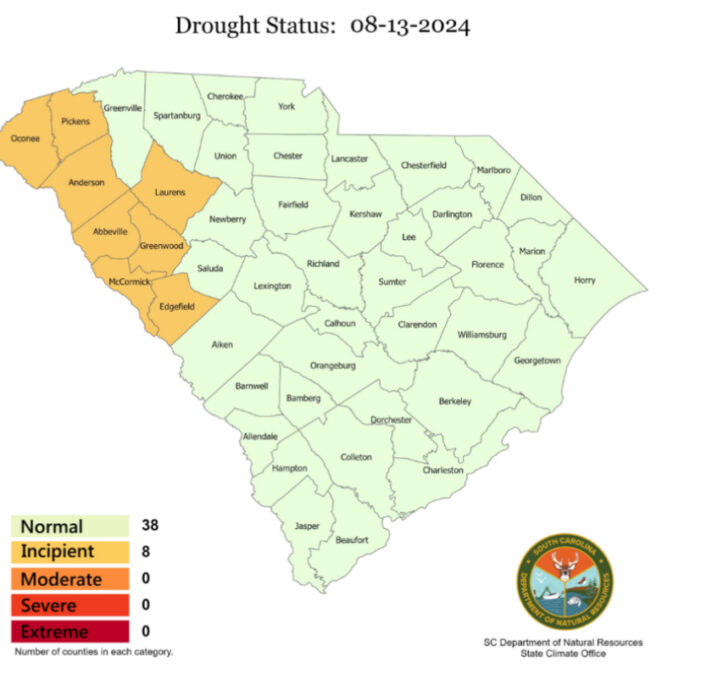Most of South Carolina is now free from drought as late-July rain and Tropical Storm Debby covered much of the state.
The S.C. Drought Response Committee, meeting via conference call Tuesday, downgraded 38 counties to normal conditions due to all the recent rain. Oconee, Anderson, and Pickens counties remain in incipient drought and the drought status was downgraded only one level — from moderate to incipient — for Abbeville, McCormick, Edgefield, Greenwood and Laurens counties.
Hope Mizzell and Elliot Wickham, with the S.C. State Climatology Office, presented drought indicators and data showing that Tropical Storm Debby brought the majority of the state between 5 to 10 inches of rain, with some locations reporting 15 to 20 inches. The counties maintained in some level of drought missed the rain, reporting less than 2 inches (See table).
Select Highest Rainfall Totals By County from Tropical Storm Debby, Aug. 5-9, 2024
Moncks Corner 6.6 SW 22.02”
Bamberg 10.96”
Prosperity 4.0 E 4.33”
Green Pond 1.3 S 17.57”
Williston 4.3 NNW 8.41”
Leesville 8.0 N 3.85”
Kingstree 7.9 NW 11.85”
Bishopville 1.4 ENE 7.62”
Edgefield 3.3N 1.98”
Holly Hill 1 SW 11.84”
Swansea 6.1 SW 6.45”
Fountain Inn 4.6 S 1.53
Mullins 11.51”
Chester 0.2 NNE 4.95”
Easley 4.8 NNE 0.48”
Rock Hill 4.8 SSW 11.30”
Spartanburg 3 SSE 4.85”
Powdersville 0.5 SSE 0.33”
“Excessive rainfall amounts in most of the state, primarily due to Tropical Storm Debby, have resulted in dramatic increases in streamflow and groundwater levels for the Coastal Plain and a significant part of the Piedmont,” said Scott Harder, hydrologist with the S.C. Department of Environmental Services. “These wet conditions supported the downgrade of the drought status to normal conditions for the entire northeast and southern Drought Management Areas (DMAs), most of the central DMA, and the southern half of the western DMA. However, counties in the upper Savannah basin and a few counties in the central DMA received notably less rainfall, and streamflow conditions have not improved as much compared to the rest of the state. Persistent below-normal flows in the upper Savannah basin have contributed to declining lake levels for Hartwell and Thurmond and has resulted in the Army Corps of Engineers declaring a Stage 1 drought level for the Savannah lakes last week. Therefore, an incipient drought status was retained for Oconee, Anderson and Pickens counties, and the drought status was downgraded only one level from moderate to incipient for Abbeville, McCormick, Edgefield, Greenwood, and Laurens counties.”
John Irwin, Laurens County cattleman and representative from the central Drought Management Area encouraged the committee to only downgrade the drought one level in Laurens and Greenwood, from moderate to incipient, based on lower rainfall totals from Debby and subsoil moisture deficiency. “It is just going to take time with the sporadic showers we are receiving to fully recover,” Irwin said.
The S.C. Forestry Commission (SCFC) has seen below average fire occurrence in recent weeks. Doug Mills, SCFC equipment and fleet manager, reported there are still a few areas that have high Keetch-Byram Drought Index numbers, but the rain and higher relative humidity has reduced fire danger in many areas.
According to Yvonne Kling, Aiken Soil and Water Conservation District chair and a drought committee member representing the western part of the state: “At the beginning of the summer farmers were in a world of hurt due to lack of spring and early summer rainfall. The recent rains some of the state has received has pulled most of us out of drought and greatly improved the grass and hay situation, but it seems it is too late for some crops. It is not a question of too little too late, but too much too late for most. We are grateful for the improved outlook for precipitation as we head to fall and figure out what profits can be made in the future for agriculture.”
Sam Quinney, agricultural outreach director with the S.C. Department of Agriculture (SCDA) said that agricultural producers are feeling the reprieve from the drought status across the state.
“SCDA and other agencies will keep a close eye on the drier conditions on the northwest side of the state and its effects on producers,” Quinney said. “Growers in the Lowcountry and Pee Dee regions are facing excess moisture issues from the heavy rains, including flooding, field and crop damage, and increased mold and disease pressure. As water levels return to a normal status, agricultural producers pray for somewhat normal growing conditions to finish out the 2024 growing season on a positive note. Please continue to pray for growers and the hardships they face this growing season and in the future.”
Drought Response Committee Chairman Ken Rentiers extended his appreciation to all committee members, meeting participants, and the Governor’s Office for their diligence over the past months in monitoring the intensifying drought, providing information, and participating in the committee meetings. The drought may be over for 38 counties, but it is important to recognize that some counties are still very much dealing with drought impacts. The State Climatology Office and the Drought Response Committee will remain vigilant in monitoring conditions and the committee will reconvene Sept. 4. |

